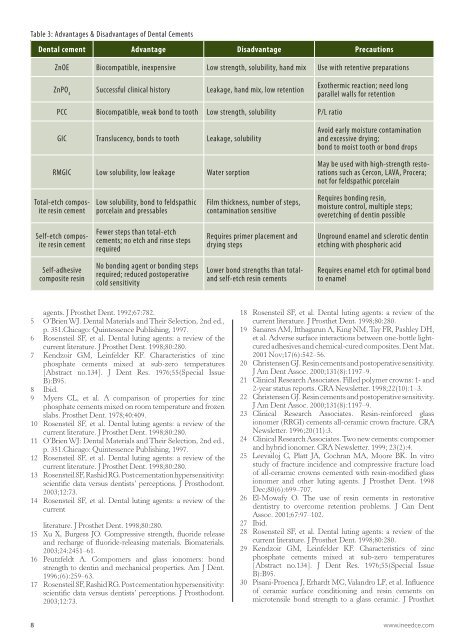A Practical Guide to the Use of Luting Cements - IneedCE.com
A Practical Guide to the Use of Luting Cements - IneedCE.com
A Practical Guide to the Use of Luting Cements - IneedCE.com
Create successful ePaper yourself
Turn your PDF publications into a flip-book with our unique Google optimized e-Paper software.
Table 3: Advantages & Disadvantages <strong>of</strong> Dental <strong>Cements</strong><br />
Dental cement Advantage Disadvantage Precautions<br />
ZnOE Bio<strong>com</strong>patible, inexpensive Low strength, solubility, hand mix <strong>Use</strong> with retentive preparations<br />
ZnPO 4<br />
Successful clinical his<strong>to</strong>ry Leakage, hand mix, low retention<br />
Exo<strong>the</strong>rmic reaction; need long<br />
parallel walls for retention<br />
PCC Bio<strong>com</strong>patible, weak bond <strong>to</strong> <strong>to</strong>oth Low strength, solubility P/L ratio<br />
GIC Translucency, bonds <strong>to</strong> <strong>to</strong>oth Leakage, solubility<br />
RMGIC Low solubility, low leakage Water sorption<br />
Avoid early moisture contamination<br />
and excessive drying;<br />
bond <strong>to</strong> moist <strong>to</strong>oth or bond drops<br />
May be used with high-strength res<strong>to</strong>rations<br />
such as Cercon, LAVA, Procera;<br />
not for feldspathic porcelain<br />
Total-etch <strong>com</strong>posite<br />
resin cement<br />
Low solubility, bond <strong>to</strong> feldspathic<br />
porcelain and pressables<br />
Film thickness, number <strong>of</strong> steps,<br />
contamination sensitive<br />
Requires bonding resin,<br />
moisture control, multiple steps;<br />
overetching <strong>of</strong> dentin possible<br />
Self-etch <strong>com</strong>posite<br />
resin cement<br />
Fewer steps than <strong>to</strong>tal-etch<br />
cements; no etch and rinse steps<br />
required<br />
Requires primer placement and<br />
drying steps<br />
Unground enamel and sclerotic dentin<br />
etching with phosphoric acid<br />
Self-adhesive<br />
<strong>com</strong>posite resin<br />
No bonding agent or bonding steps<br />
required; reduced pos<strong>to</strong>perative<br />
cold sensitivity<br />
Lower bond strengths than <strong>to</strong>taland<br />
self-etch resin cements<br />
Requires enamel etch for optimal bond<br />
<strong>to</strong> enamel<br />
agents. J Pros<strong>the</strong>t Dent. 1992;67:782.<br />
5 O’Brien WJ. Dental Materials and Their Selection, 2nd ed.,<br />
p. 351.Chicago: Quintessence Publishing, 1997.<br />
6 Rosensteil SF, et al. Dental luting agents: a review <strong>of</strong> <strong>the</strong><br />
current literature. J Pros<strong>the</strong>t Dent. 1998;80:280.<br />
7 Kendzoir GM, Leinfelder KF. Characteristics <strong>of</strong> zinc<br />
phosphate cements mixed at sub-zero temperatures<br />
[Abstract no.134]. J Dent Res. 1976;55(Special Issue<br />
B):B95.<br />
8 Ibid.<br />
9 Myers CL, et al. A <strong>com</strong>parison <strong>of</strong> properties for zinc<br />
phosphate cements mixed on room temperature and frozen<br />
slabs. Pros<strong>the</strong>t Dent. 1978;40:409.<br />
10 Rosensteil SF, et al. Dental luting agents: a review <strong>of</strong> <strong>the</strong><br />
current literature. J Pros<strong>the</strong>t Dent. 1998;80:280.<br />
11 O’Brien WJ: Dental Materials and Their Selection, 2nd ed.,<br />
p. 351.Chicago: Quintessence Publishing, 1997.<br />
12 Rosensteil SF, et al. Dental luting agents: a review <strong>of</strong> <strong>the</strong><br />
current literature. J Pros<strong>the</strong>t Dent. 1998;80:280.<br />
13 Rosensteil SF, Rashid RG. Post cementation hypersensitivity:<br />
scientific data versus dentists’ perceptions. J Prosthodont.<br />
2003;12:73.<br />
14 Rosensteil SF, et al. Dental luting agents: a review <strong>of</strong> <strong>the</strong><br />
current<br />
literature. J Pros<strong>the</strong>t Dent. 1998;80:280.<br />
15 Xu X, Burgess JO. Compressive strength, fluoride release<br />
and recharge <strong>of</strong> fluoride-releasing materials. Biomaterials.<br />
2003;24:2451–61.<br />
16 Peutzfeldt A. Compomers and glass ionomers: bond<br />
strength <strong>to</strong> dentin and mechanical properties. Am J Dent.<br />
1996;(6):259–63.<br />
17 Rosensteil SF, Rashid RG. Post cementation hypersensitivity:<br />
scientific data versus dentists’ perceptions. J Prosthodont.<br />
2003;12:73.<br />
18 Rosensteil SF, et al. Dental luting agents: a review <strong>of</strong> <strong>the</strong><br />
current literature. J Pros<strong>the</strong>t Dent. 1998;80:280.<br />
19 Sanares AM, Itthagarun A, King NM, Tay FR, Pashley DH,<br />
et al. Adverse surface interactions between one-bottle lightcured<br />
adhesives and chemical-cured <strong>com</strong>posites. Dent Mat.<br />
2001 Nov;17(6):542–56.<br />
20 Christensen GJ. Resin cements and pos<strong>to</strong>perative sensitivity.<br />
J Am Dent Assoc. 2000;131(8):1197–9.<br />
21 Clinical Research Associates. Filled polymer crowns: 1- and<br />
2-year status reports. CRA Newsletter. 1998;22(10):1–3.<br />
22 Christensen GJ. Resin cements and pos<strong>to</strong>perative sensitivity.<br />
J Am Dent Assoc. 2000;131(8):1197–9.<br />
23 Clinical Research Associates. Resin-reinforced glass<br />
ionomer (RRGI) cements all-ceramic crown fracture. CRA<br />
Newsletter. 1996;20(11):3.<br />
24 Clinical Research Associates. Two new cements: <strong>com</strong>pomer<br />
and hybrid ionomer. CRA Newsletter. 1999; 23(2):4.<br />
25 Leevailoj C, Platt JA, Cochran MA, Moore BK. In vitro<br />
study <strong>of</strong> fracture incidence and <strong>com</strong>pressive fracture load<br />
<strong>of</strong> all-ceramic crowns cemented with resin-modified glass<br />
ionomer and o<strong>the</strong>r luting agents. J Pros<strong>the</strong>t Dent. 1998<br />
Dec;80(6):699–707.<br />
26 El-Mowafy O. The use <strong>of</strong> resin cements in res<strong>to</strong>rative<br />
dentistry <strong>to</strong> over<strong>com</strong>e retention problems. J Can Dent<br />
Assoc. 2001;67:97–102.<br />
27 Ibid.<br />
28 Rosensteil SF, et al. Dental luting agents: a review <strong>of</strong> <strong>the</strong><br />
current literature. J Pros<strong>the</strong>t Dent. 1998;80:280.<br />
29 Kendzoir GM, Leinfelder KF. Characteristics <strong>of</strong> zinc<br />
phosphate cements mixed at sub-zero temperatures<br />
[Abstract no.134]. J Dent Res. 1976;55(Special Issue<br />
B):B95.<br />
30 Pisani-Proenca J, Erhardt MC, Valandro LF, et al. Influence<br />
<strong>of</strong> ceramic surface conditioning and resin cements on<br />
microtensile bond strength <strong>to</strong> a glass ceramic. J Pros<strong>the</strong>t<br />
8 www.ineedce.<strong>com</strong>
















